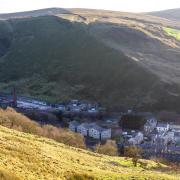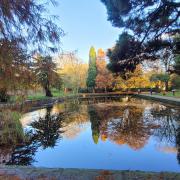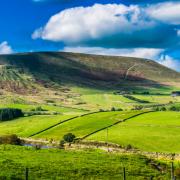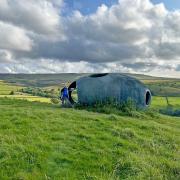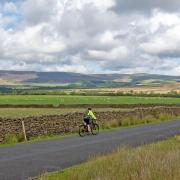Keith Carter stands out from the crowd by wearing his walking boots in Bowness
What would you say to someone who, never having visited the Lake District before, asked where they should start?
For some, the natural starting point would be the longest and largest of the lakes, Windermere. It’s the most southerly and the most accessible. You can paddle in it, picnic beside it, go boating on it, feed the ducks, skim stones, fish (cast a line that is), even swim in it. The lake is so easy to access it's like one big play-park and what’s more, there are three towns at its edge, Bowness,Windermere and Ambleside.
Bowness and Windermere were once two quite separate places but urban development has joined them up and now it’s hard to tell where one ends and the other begins.
Bowness should be called by its correct name of Bowness-on-Windermere so as not to confuse it with Bowness-on-Solway, to say nothing of Bo’ness which I think is up north somewhere.

Windermere was originally Birthwaite until the railway reached it, at which time it was thought advisable to rename it to help boost tourism.
Bowness is a honey-pot for day-trippers in the summer and could be mistaken for Blackpool on a busy Bank Holiday. It has tea-shops, pubs, bistros, fast food and fine dining, and nobody is going to be stuck for food or accommodation.What it doesn’t have a lot of is walkers, being off the normal fell-walkers orbit with no mighty tops to tackle in the vicinity.
There are some good walks to be done from Bowness though and it is the destination for intrepid Dales Way stalwarts who have slogged it all the way from Ilkley, a distance of 81 miles to the Royal Oak pub, the official end of the route.
The most convenient place to leave the car for this walk is the Lake Cruises car park on the corner of Rectory Road. You pay at the kiosk and you’ll need to allow four hours, more if you intend to mooch about in Bowness. Turn left out of the car park and make your way along the promenade where the cruisers come in. The kiosks have been here since the early 1900s when the town was in its heyday. The Old England Hotel must have seen its share of top hats and wedding gowns and still retains a certain aloof superiority to the flip flop and ice-cream brigade.
Passing the hotel on the left, take the next turning on the right, Brantfell Road and climb away from the bustling centre past the old schoolhouse where a marble plaque commemorates the benevolence of one John Hopkins who endowed it. Sadly he didn't live to see it completed but luckily his ‘pious widow’ saw that it was done as he would have wanted.
At the top of Brantfell Road a gate gives access to the fell and a footpath sign tells us that this is the Dales Way. Climb to the next gate and keep ahead to where the path divides.We go left, the right hand one leading to Brant Fell, a popular goal for many people who go up there for the view.
We keep left, go through another gate and at the next one keep forward to where a metal gate under a spreading sycamore is seen in the wall on our right. Follow a faint path slightly left and a further metal gate leads us to meet a lane. Go right for a few paces until a fingerpost on the left points the way to Cleabarrow and Matson Ground. At the next kissing-gate turn right along a stand of mature trees passing a duck-pond on the left and at the next kissing-gate we come to a meeting of ways.
Cross over to yet another kissing-gate and follow an enclosed path, cross a lane and enter a field. Keep to the right of a fenced copse on a faint path marked by posts with Dales Way arrows on them. At a gate in thecorner, ford a beck and keep ahead, the route well marked at this stage.
After a further two kissing-gates we pass through a grove of young cherry trees and then keep along a left hand wall to a hand-gate at the top. Go through it to a lane and turn right until we meet the road with the gated entrance to East Cleabarrow on our left.
In the stone wall on the left some steps lead to a path designed to keep walkers off the road, emerging at a lay-by where there are usually a few cars parked. A sign pointing up a minor lane to the left reassures us that we are still on the Dales Way.
Take this lane and at the top of the brow by a house called Parrock Cross keep ahead on a stony track. Stay with this through several gates until you come to a path junction where the Dales Way turns sharply right.We do too, the path climbing gradually to where two leaning pine trees seem to keep guard over the fell. Don't go through the gateway as the Dales Way does since this is where we part company with it, unless we want to go to Ilkley.
Keep ahead along a right-hand wall as far as School Knott Tarn. At the tarn, branch off left on a faint path that goes through a gate then heads up to the top of School Knott, at 232m (761ft) a higher top than Brant Fell though less well known. Look down over the clustered houses below, across the expanse of Windermere to the panorama of hills on the skyline - what a fantastic view.What’s the word to describe it?
Breathtaking? Awe-inspiring? Majestic? They don’t do it justice.
Descend towards the town and when a wall crosses our path go through a tall, narrow hand-gate and take the left hand of two paths that go down through mixed scrubland. Cross a path and go through a second similar gate to emerge onto a quiet cul-de-sac.
From here it is a case of weaving a way through the suburban streets to regain Lake Road back into the centre. It is not difficult and if you follow these directions you should have no problem.
Turn right on to Fairfield Road then left onto Limethwaite road to a crossroads with Heathwaite post office stores on the corner. Cross straight over into Oakthwaite Road and just before the T-junction take a footpath on the right that leads to Oldfield Road. The path cuts left along a stream and on reaching its end, turn left then immediate right onto Thornbarrow Road.
At the bottom, turn left onto Lake Road and follow it all the way back into Bowness. Don’t let the crowds put you off the idea of a half of Hawkshead bitter in the Angel Inn, just the place to remind yourself of how much you like this heavenly beer.
Factfile
Area of walk: Bowness-on-Windermere
Distance: Five miles
Time to allow: 3 � hours
Map: OS Explorer OL7 The English Lakes South eastern area.
Refreshments: Endless choice in Bowness.
Toilets: Beside Tourist Information Centre.
Useful book: The Good Guide to the Lakes by Tom Holman and Hunter Davies.




